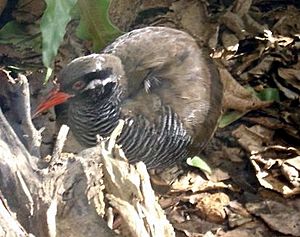Okinawa rail facts for kids
Quick facts for kids Okinawa rail |
|
|---|---|
 |
|
| Conservation status | |
| Scientific classification | |
| Synonyms | |
|
The Okinawa rail (Gallirallus okinawae) is a special type of bird that lives only on Okinawa Island in Japan. This means it is endemic to that island. Local people call it the Yanbaru kuina, which means 'Yanbaru rail'. They also have other names for it like Agathi or Agacha, meaning 'hurry', and Yamadhui, meaning 'mountain bird'.
Contents
What the Okinawa Rail Looks Like
The Okinawa rail is about 30 centimeters (12 inches) long. Its wingspan is around 50 centimeters (20 inches). It weighs about 435 grams (15 ounces). Its face is black. It has a white spot between its beak and eye. A white line goes from behind its eye to the side of its neck. The feathers under its tail are dark brown with light stripes. Its wings are 15-16 centimeters long. Its eggs are about 5 centimeters long and 3.5 centimeters wide. The bird's beak and eyes are brownish. Its legs and feet are yellow.
Where the Okinawa Rail Lives
This bird lives in warm, wet forests called subtropical moist forests. It also lives in areas close to these forests. You can find it in evergreen broad-leaved forests. These forests are often about 500 meters (1,640 feet) above sea level.
What the Okinawa Rail Eats and How it Communicates
The Okinawa rail eats many small creatures. It often finds food near roads and at the edge of forests. It also eats prey that live in areas with water. This bird is quite noisy and makes many different loud sounds. It calls most often in the early morning and late evening. It usually calls from the ground, but sometimes from trees. Pairs of birds often call together. Up to 12 birds have been heard calling in one area.
How Humans Affect the Okinawa Rail
The number of Okinawa rails is decreasing. This is because of several reasons related to human activities.
- Habitat Loss: Forests are being cut down for wood. Land is also being used for farming. This destroys and breaks up the places where the birds live.
- Roads and Dams: Building forest roads and dams also harms their habitat.
- Traffic Accidents: Young birds, called chicks, sometimes slide into ditches next to roads. This can lead to them getting hurt or dying.
- Introduced Animals: Animals brought to the island by humans, like dogs, cats (sometimes called nonneko), and mongooses, hunt the rails. This also makes their numbers go down.
Images for kids
See also
 In Spanish: Rascón de Okinawa para niños
In Spanish: Rascón de Okinawa para niños



